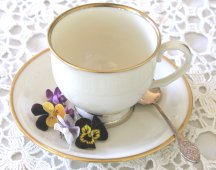Tea?
By SnIcKasS
@SnIcKasS (1375)
Israel
4 responses
@howard96h (11640)
• New York, New York
25 Feb 07
Once in a while, I prefer my coffee in the morning.
@Marie2473 (8512)
• Sweden
25 Feb 07
I love tea - howwever I almost never have time to sit down and have a cup. I do like the different teakinds that are, fruti tea, min tea and earl grey tea =)
I wish I could have a cup right now.. hey - I can - we have alot here at work!
@ukchriss (2097)
•
25 Feb 07
Yes I drink a lot of tea, always in a mug!
Tea is by far the most popular drink consumed in Britain today. Did you know that, Drinking regular cups of tea could help improve your memory,
The latest research has shown that your daily cuppa provides you with antioxidants, contributes successfully to your daily fluid target and the low caffeine levels found in tea mean that you need never feel guilty about reaching for the tea pot.
Tea is grown in many countries in the world.
You have probably heard about Indian and China tea, but did you know that tea is grown in Africa and Indonesia?
Health Facts and Nutrition Data
Approximately 40% of the nation's fluid intake today will be tea
Tea without milk has no calories.
Using semi-skimmed milk adds around 13 calories per cup,
but you also benefit from valuable minerals and calcium.
Tea with milk provides 21% of daily calcium requirement in 4 cups.
Tea contains some zinc and folic acid.
Tea with milk contains Vitamin B6, Riboflavin B2 and Thiamine B1.
Tea is a source of the minerals manganese, essential for bone growth and body development, and potassium, vital for maintaining body fluid levels.
The average cup of tea contains less than half the level of caffeine than coffee, One cup contains only 50mg per 190ml cup.
Tea is a natural source of fluoride and drinking four cups makes a significant contribution to your daily intake,
Only 11% of UK water supply has fluoride added.
Green and black teas are from the same plant, Camelia sinensis, and contain similar amounts of antioxidants and caffeine








